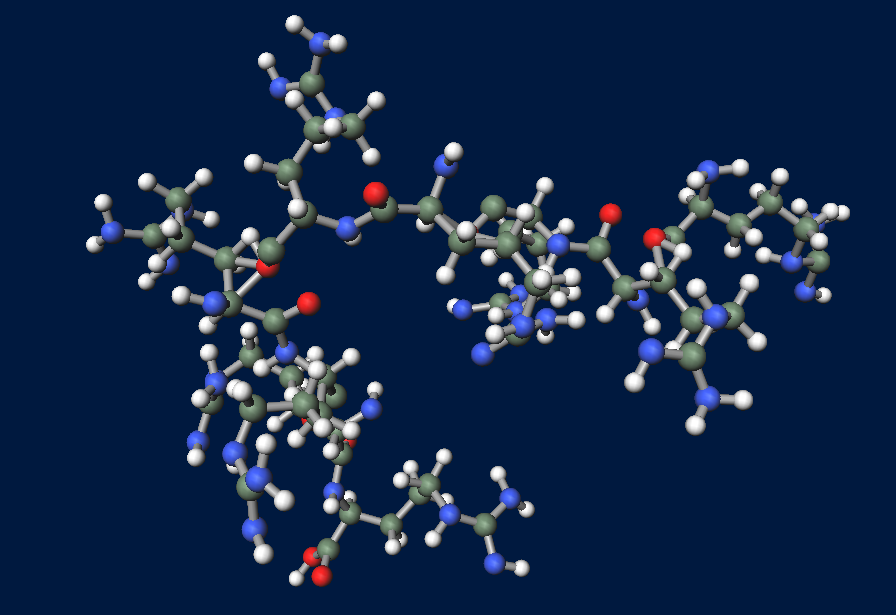Team:Kyoto/Florigen/Project
From 2012.igem.org
(→What is R9 peptide?) |
(→What is R9 peptide?) |
||
| Line 10: | Line 10: | ||
====What is R9 peptide?==== | ====What is R9 peptide?==== | ||
| - | [[File:R9peptide. | + | [[File:R9peptide.png|right|300px|image of R9 peptide]]To realize flower fairy E. coli, FT secreted by E. coli must be absorbed in plant cells. We used polyarginine, a type of cell penetrating peptide (CPP), to transport FT protein into plant cells. The type is R9 peptide, which comprises a sequence conjugated to nine arginine residues. Polyarginine peptide is thought to act on a cell membrane and cause a specific form of endocytosis, that is, macropinocytosis. Macropinocytosis is not caused by an invagination of the cell membrane, but by the growth on the actin mambrane from protrusions into vesicles called macropinosomes, and no receptors are necessary for the process. It is reported that plants use CPP to transport biomolecules such as proteins inside the cell, in spite of their cell walls. |
<br> | <br> | ||
Revision as of 06:29, 19 September 2012
Contents |
Introduction
What is Florigen?
It has always been a human dream to control the flowering of plants at will, and various studies have been done to realize this dream. Little was known about froligen, a plant hormone which promotes flowering for about seventy years since the existence of the hormone was suggested and it was named froligen, but recent studies have revealed more and more about it.
Froligen is a 20kDa of small protein composed of 175 amino acids which are encoded by the FLOWERING LOCUS T (FT) gene. The expression of the FT gene is promoted inside the leaf phloem companion cells by several specific conditions such as long photoperiods, vermalisation, age and so on. After transcripted, FT mRNA is translated into a protein and then transported to the shoot apex thorough sieve tubes. In the shoot apex, FT is combined with FD, which works as a transcriptional factor, and activates floral meristem identity genes such as APETALA 1 (AP1), FRUITFUL (FUL), and LEAFY (LFY). These genes play a significant role in the transformation of the form of a shoot meristem, converting it into a flower bud. Considering the effect of FT on flowering as mentioned above, we can say that E. coli with a capacity of producing FT are able to bloom flowers, as if they were flower fairies!
What is R9 peptide?
To realize flower fairy E. coli, FT secreted by E. coli must be absorbed in plant cells. We used polyarginine, a type of cell penetrating peptide (CPP), to transport FT protein into plant cells. The type is R9 peptide, which comprises a sequence conjugated to nine arginine residues. Polyarginine peptide is thought to act on a cell membrane and cause a specific form of endocytosis, that is, macropinocytosis. Macropinocytosis is not caused by an invagination of the cell membrane, but by the growth on the actin mambrane from protrusions into vesicles called macropinosomes, and no receptors are necessary for the process. It is reported that plants use CPP to transport biomolecules such as proteins inside the cell, in spite of their cell walls.
powered by winmostar V3.808d
Method
1. Expression of FT in E.coli
Construction
FT gene has 2 BioBrick restriction enzyme sites, EcoR1 and Pst1. So we did mutation to delete the sites before we start construction.
We constructed the following plasmid to check the expression of FT by Western blotting, using FT specific antibody. FT is regulated by T7 promoter, BBa_I719005 and strong RBS, BBa_B0034.
コンストラクション図
Western blotting
Cells were precultured overnight and diluted into fresh SOC medium. IPTG was added when OD600 was approx. 0.7, then cells were incubated for 4h at 37°C. µL of culture was used for SDS-PAGE.
2. GFP imaging assay for characterizing R9 peptide
Following plasmid was constructed to check the function of R9 peptide.
3. RT-PCR assay for characterizing FT
Result
Discussion
Reference
[1]Microsugar Chang et al. (2005)"Cellular internalization of fluorescent proteins via arginine-rich intracellular delivery peptide in plant cells" Plant Cell Physiol, 46(3), 482–488
[2]Paula Teper-Bamnolker and Alon Samach1 (2005) "The flowering integrator FT regulates SEPALLATA3 and
FRUITFULL accumulation in Arabidopsis leaves" The Plant Cell, 17, 2661–2675
[3]Philip A. Wigge et al. "Integration of spatial and temporal information during floral induction in Arabidopsis
[4]Sara Trabulo et al.(2010). "Cell-penetrating peptides—mechanisms of cellular uptake and generation of delivery systems" Pharmaceuticals, 3, 961-993
 "
"







